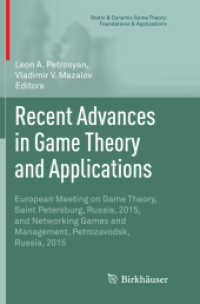- ホーム
- > 洋書
- > 英文書
- > Computer / General
Full Description
How to Think Like a Programmer is a bright, accessible, fun read describing the mindset and mental methods of programmers. Anticipating the problems that students have through the character of Brian the Bewildered Wildebeest, the slower pace required for this approach is made interesting and engaging by hand-drawn sketches, frequent (paper-based) activities and the everyday tasks (e.g. coffee making) used as a basis of worked examples. How to Think Like a Programmer provides a fun and accessible way to learn the mental models needed to approach computational programmable problems.
This edition is printed in black and white.
Contents
PART I THE REAL WORLD DOMAIN: PROBLEM SOLVING AND SYSTEMATIZING THE SOLUTION
1. Introduction: Starting to Think Like a Programmer
2. A Strategy for Solving Problems
3. Description Languages & Representations
4. Problems of Choices and Repeated Actions
5. Calculating and Keeping Track of Things
6. Extending our Vocabulary: Data & Control Abstractions
7. Object Orientation: Taking a Different View
8. Looking Forward to Program Design
PART II THE COMPUTER DOMAIN: DATA, DATA STRUCTURES, AND PROGRAM DESIGN SOLUTIONS
9. Data Types For Computer Programs
10. Sub-Programming and Baking Cakes: Procedures and Functions
11. Streams and Files, Input and Output
12. Static Data Structures
13. Dynamic Data Structures
14. Object-Orientation Revisited
15. Getting it to Run in Processing: Putting your Programs into a Real Programming Language
16. Testing, Debugging, and Documentation








